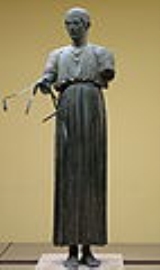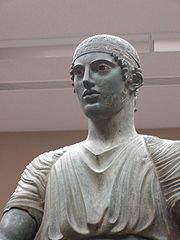
Charioteer of Delphi
Encyclopedia

Rein
Reins are items of horse tack, used to direct a horse or other animal used for riding or driving. Reins can be made of leather, nylon, metal, or other materials, and attach to a bridle via either its bit or its noseband.-Use for riding:...
-holder), is one of the best-known statues surviving from Ancient Greece
Ancient Greece
Ancient Greece is a civilization belonging to a period of Greek history that lasted from the Archaic period of the 8th to 6th centuries BC to the end of antiquity. Immediately following this period was the beginning of the Early Middle Ages and the Byzantine era. Included in Ancient Greece is the...
, and is considered one of the finest examples of ancient bronze statues. The life-size statue of a chariot
Chariot racing
Chariot racing was one of the most popular ancient Greek, Roman and Byzantine sports. Chariot racing was often dangerous to both driver and horse as they frequently suffered serious injury and even death, but generated strong spectator enthusiasm...
driver was found in 1896 at the Sanctuary of Apollo
Apollo
Apollo is one of the most important and complex of the Olympian deities in Greek and Roman mythology...
in Delphi
Delphi
Delphi is both an archaeological site and a modern town in Greece on the south-western spur of Mount Parnassus in the valley of Phocis.In Greek mythology, Delphi was the site of the Delphic oracle, the most important oracle in the classical Greek world, and a major site for the worship of the god...
. It is now in the Delphi Archaeological Museum
Delphi Archaeological Museum
Delphi Archaeological museum is the museum that houses the ancient artifacts that were found in Delphi, Greece. Its centerpiece are the antiquities found in the complex of the ancient Oracle of Delphi from the 18th century BC when the oracle was founded to its decline in Late Antiquity...
.
The statue was erected at Delphi in 474 BC, to commemorate the victory of a chariot
Chariot racing
Chariot racing was one of the most popular ancient Greek, Roman and Byzantine sports. Chariot racing was often dangerous to both driver and horse as they frequently suffered serious injury and even death, but generated strong spectator enthusiasm...
team in the Pythian Games
Pythian Games
The Pythian Games were one of the four Panhellenic Games of Ancient Greece, a forerunner of the modern Olympic Games, held every four years at the sanctuary of Apollo at Delphi....
, which were held at Delphi every four years in honor of Pythean Apollo. It was originally part of a larger group of statuary, including the chariot, four (possibly six) horses and two grooms. Some fragments of the horses were found with the statue. When intact, it must have been one of the most imposing works of statuary in the world.
An inscription on the limestone base of the statue shows that it was commissioned by Polyzalus, the tyrant
Tyrant
A tyrant was originally one who illegally seized and controlled a governmental power in a polis. Tyrants were a group of individuals who took over many Greek poleis during the uprising of the middle classes in the sixth and seventh centuries BC, ousting the aristocratic governments.Plato and...
of Gela
Gela
Gela is a town and comune in the province of Caltanissetta in the south of Sicily, Italy. The city is at about 84 kilometers distance from the city of Caltanissetta, on the Mediterranean Sea. The city has a larger population than the provincial capital, and ranks second in land area.Gela is an...
, a Greek colony in Sicily
Sicily
Sicily is a region of Italy, and is the largest island in the Mediterranean Sea. Along with the surrounding minor islands, it constitutes an autonomous region of Italy, the Regione Autonoma Siciliana Sicily has a rich and unique culture, especially with regard to the arts, music, literature,...
, as a tribute to Apollo for helping him win the chariot race
Chariot racing
Chariot racing was one of the most popular ancient Greek, Roman and Byzantine sports. Chariot racing was often dangerous to both driver and horse as they frequently suffered serious injury and even death, but generated strong spectator enthusiasm...
. The inscription reads:
The Sicilian
Sicily
Sicily is a region of Italy, and is the largest island in the Mediterranean Sea. Along with the surrounding minor islands, it constitutes an autonomous region of Italy, the Regione Autonoma Siciliana Sicily has a rich and unique culture, especially with regard to the arts, music, literature,...
cities were very wealthy compared with most of the cities of mainland Greece and their rulers could afford the most magnificent offerings to the gods, also the best horses and drivers. It is unlikely, however, the statue itself comes from Sicily. The name of the sculptor is unknown, but for stylistic reasons it is believed that the statue was cast in Athens
Athens
Athens , is the capital and largest city of Greece. Athens dominates the Attica region and is one of the world's oldest cities, as its recorded history spans around 3,400 years. Classical Athens was a powerful city-state...
. It has certain similarities of detail to the statue known as the Piraeus Apollo
Piraeus Apollo
Piraeus Apollo is the name of an archaic-style bronze dating from the 6th century BC,possibly from the years 530-520 BC,exhibited now at the Archaeological Museum of Piraeus .Apollo was the god of the ideal order and balance and the depictions of naked young men in the Kouros type are believed to...
, which is known to be of Athenian origin.
The Charioteer himself is intact except that his left arm is missing. Greek bronzes were cast
Molding (process)
Molding or moulding is the process of manufacturing by shaping pliable raw material using a rigid frame or model called a pattern....
in sections and then assembled. When discovered, the statue was in three pieces—head and upper torso, lower torso, and right arm. The left arm was probably detached and lost before the statue was buried. This was probably done to protect it from looters, some time after the Sanctuary at Delphi was closed in the 4th century AD.

The figure is of a very young man, as is shown by his soft side-curls. Like modern jockeys, chariot racers were chosen for their lightness, but also needed to be tall, so they were frequently teenagers. He is wearing a xystis, the garment which drivers wore while racing. It falls to his ankles and is fastened high at the waist with a plain belt. The two straps that cross high at his upper back prevented the xystis from "ballooning" during the race.
Stylistically, the Charioteer is classed as "Early Classical" or "Severe" (see Greek art
Greek art
Greek art began in the Cycladic and Minoan prehistorical civilization, and gave birth to Western classical art in the ancient period...
). The statue is more naturalistic than the kouroi
Kouros
A kouros is the modern term given to those representations of male youths which first appear in the Archaic period in Greece. The term kouros, meaning youth, was first proposed for what were previously thought to be depictions of Apollo by V. I...
of the Archaic period, but the pose is still very rigid when compared with later works of the Classical period. One departure from the Archaic style is that the head is inclined slightly to one side. The naturalistic rendering of his feet was greatly admired in ancient times. This sculpture displays several advancements on Archaic sculpting style - the introverted expression does away with the old 'Archaic smile' and he would not have been clothed in the Archaic period. His robes are a testament to the talent of the sculptor. There would have been a chariot to cover most of the waist and below, so not much interested is added to his robes, however.
More pictures at Wikimedia Commons. http://commons.wikimedia.org/wiki/Category:Charioteer_of_Delphi
External links
- Charioteer of Delphi. Ancient Greece.
- Charioteer of Delphi. University of Saskatchewan.

